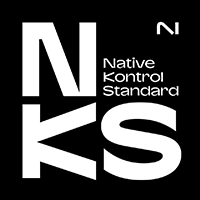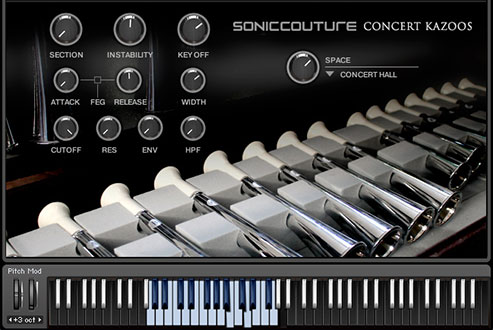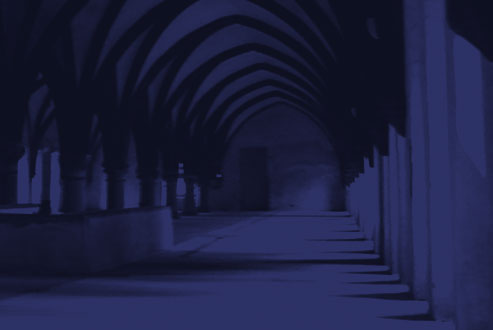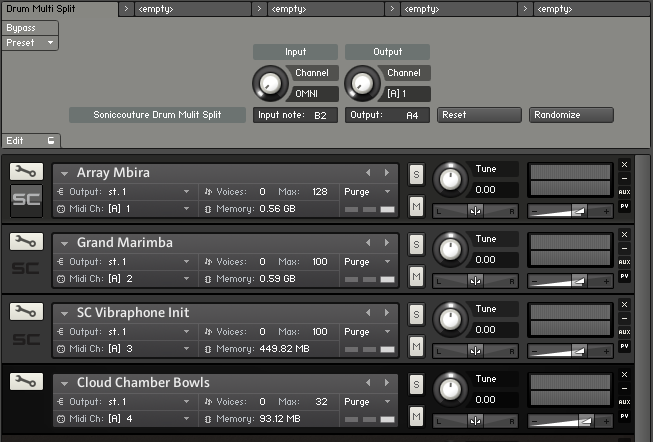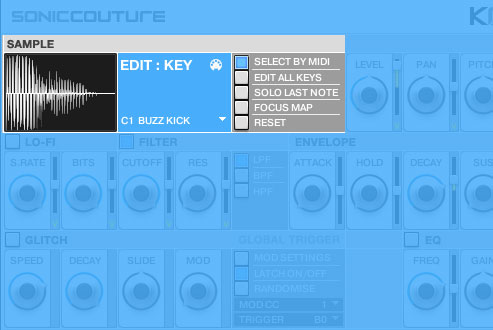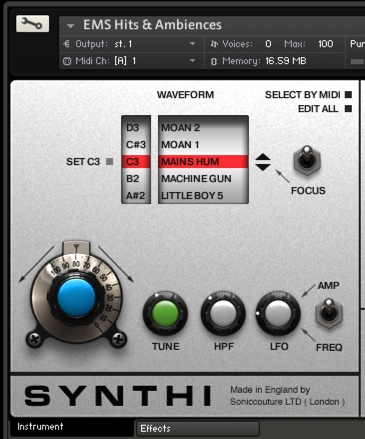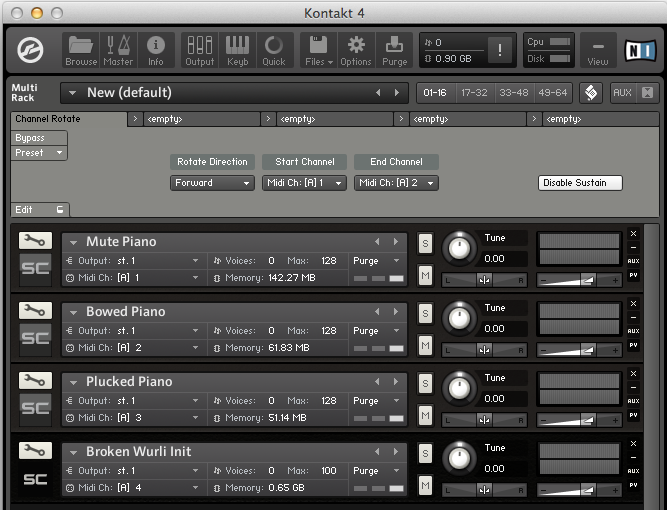Blog Menu
Go Kazoos.
Go Kazoos.
By James Thompson | 05.04.2014
On April 1st we released Concert Kazoos – a free instrument featuring 25 tuned kazoos/ mouth horns, made by Suzuki.
Was it a joke? Yes and no – we really did release the instrument, and it really was made of recordings of 25 tuned kazoos etc etc. We liked the idea of doing an April Fools release, but at the same time,
Read MoreOn April 1st we released Concert Kazoos – a free instrument featuring 25 tuned kazoos/ mouth horns, made by Suzuki.
Was it a joke? Yes and no – we really did release the instrument, and it really was made of recordings of 25 tuned kazoos etc etc. We liked the idea of doing an April Fools release, but at the same time, we didn’t want it to be an empty trick. So, although the seriousness of the release was played up in a very deadpan way, as though it might be a trick, it wasn’t really. Does that make it a real April Fools? I don’t know, probably not.
What is clear is that the kazoos actually sounded pretty good – and people really seem to appreciate them, more than expected.
If you haven’t downloaded Concert Kazoos yet, you can check them out here ( you just need to sign up for an account first.)
Concert Kazoos & Other Free Downloads
Close Close
Scriptorium : Multi-Drum Split (Prepared Kontakt)
Scriptorium : Multi-Drum Split (Prepared Kontakt)
By Dan Powell | 24.03.2014
In the post about Keyboard Split I mentioned that the same script could be edited to enable every input note to have a it’s own output channel and MIDI note. Nobody took up the challenge, but a couple of people wrote with ideas about how that should be done, so here’s the version I’ve made.
Read MoreThe original idea was that this would be useful for building large multi-channel drum kits, since each note can be sent to any channel or output note. But it’s also interesting with pitched instruments to build up prepared-piano-type patch ideas in which each note has a different sound.
Here’s a video made using ten instruments and a randomly generated note assignment, resulting in a kind of Prepared Kontakt:
On the script panel you can set the input channel to OMNI or else select a single input channel if necessary. The Output Channel and Output Note can be set independently for all Input Notes.
If you hold down ALT when you adjust the Output Channel, all the notes will have the same Output Channel. If you click Reset, all the notes will be set to the input note, a kind of default map.
If you click Randomize you’ll see another page with some parameters for randomising the setup. Here you can set the From and To limits for the Channel, as well as the From and To limits for the Notes to Randomise. Using this carefully you can safely randomise just a section of your setup, even if you’ve edited another part of the keyboard by hand already. You have the option to Cancel, or else “Do It!”, after which you’ll be returned to the main page.
The script will be saved with a Multi, so save your Multis to save your setups. It may be quicker to replace instruments in a multi than to carefully arrange a pattern of note/channel routings with the script.
Thanks to Jörg Schwickerath and Christopher Merritt for their input and feedback.
Works with Kontakt 4.2.4 or later.
Close CloseBringing One-shot Sampling Into Focus
Bringing One-shot Sampling Into Focus
By James Thompson | 21.02.2014
In recent Soniccouture instruments you will find a feature called ‘Focus’ – unique to SC, this is an extremely useful way of working with larger collections of related but different single samples; drum sounds in Konkrete 3, field recordings in Geosonics and now hits and one shots in Attic: Synthi AKS (coming soon).
As instruments designers, we had always been niggled by a certain issue: how to present a collection of single samples in a usable way?
Read MoreIn recent Soniccouture instruments you will find a feature called ‘Focus’ – unique to SC, this is an extremely useful way of working with larger collections of related but different single samples; drum sounds in Konkrete 3, field recordings in Geosonics and now hits and one shots in Attic: Synthi AKS (coming soon).
As instruments designers, we had always been niggled by a certain issue: how to present a collection of single samples in a usable way? Historically, developers only really had one choice – to make one patch or instrument for each single sample,with it stretched over the keyrange, centred on C3 ready for playing. This is functional enough for the single sound, but presents the big problem of having to load a new patch to audition the next single sample. In a collection of 200 or 300 (or more) samples this would make the exercise of stepping through looking for inspiration very long-winded, and in many cases, totally off-putting.
I suspect that this had the knock-on negative effect of devaluing sample libraries composed solely of one-shot samples in the minds of the users. People are understandably not so happy to pay much for a more or less unsorted mass of samples, even if they are broken down into folders etc – the end product inevitably lacks cohesion and smooth work-flow.
Which is why I breathed a sigh of relief the day that Dan told me about his ‘Focus’ idea. Suddenly all those product ideas we had previously dismissed because we didn’t like to present endless single-sample patches became viable again.
How The Focus Feature Works
A Soniccouture Focus instrument is a large collection of single samples presented on the MIDI keyboard, mapped to one single key each. So, as you play each key you hear a different sound. Very easy.
If you find a sound you like and want to use, just hit the ‘FOCUS’ button and that sound is automatically mapped across the entire width of the keyboard, tuned chromatically and centred on C3. Just the way you like it (probably). All the other sounds are no longer audible, unless you turn ‘FOCUS’ off again. You can edit all, or just one, of the samples at once.
And that’s it – a simple solution that has really revolutionised how we design products based around single samples. Geosonics, for example, would not be nearly as simple to navigate without it; either the user would have to listen through 10+ minutes of field recording for each patch, or we would have had to present each recording as 50 to 100 different excerpts, in the old-fashioned long list.
You can see a video demonstration of Focus mode in Geosonics in this video, from 1m 40s onwards:
Focus On Drums
In Konkrete 3 its function is subtly different – because the single sounds are already organised and presented as drum kits, Focus operates more as an ‘instrumentizer’ – you can instantly make a melodic, tuned patch out of any single percussion sample, and play a bassline or lead.
A video demonstration of Focus Mode with drums in Konkrete 3
Focus With Synthesis
I’m excited all over again by Focus and its possibilities as we come to the end of working on the somewhat epic Project Attic. A venerable old SC product, Synthi AKS, has had a major refurb and update, and has really been brought to life by Focus technology. Part of the original Synthi product was a collection of one shot effects and hits made by patching the famous ‘pin-matrix’ of modulation routings on the original unit. This is not really suited to multi-sampling or any 21st century ‘deep-sampling’ treatments; it’s just about very cool individual sounds that often only happen once, such is the unpredictability of the E.M.S. machine. Here we were able to gather together the most characterful sounds of the Synthi and put them all into one Kontakt instrument, where they can be played one key at a time as a kind of mad all-in-one Doctor Who patch, or then converted instantly to very playable tuned patches with Focus mode.
Look out for the new Synthi AKS ( in The Attic) coming Q1 2014.
Close Close
Scriptorium : Binaural Beats II
Scriptorium : Binaural Beats II
By Dan Powell | 13.02.2014
Binaural Beats is a complete rebuild of an earlier script in our Scriptorium package, originally titled Brainwave Detune. This is a special kind of detune effect.
Usually detune is specified as a constant cents difference between two signals, but Binaural Beats detunes by a constant frequency difference. This means that the beat frequency between the signals is constant across the keyboard range.
Read MoreThis is an effect often found in new-age binaural beating meditation recordings. Folk wisdom suggests that when these frequencies are perceived by the brain within binaural audio, the brain becomes entrained by the frequencies and enters a similar resonant pattern itself, thus putting the listener into a desired mental state. There is absolutely no medical or scientific evidence for this.
In Brainwave Detune we offered a few fixed Brainwave choices, but in the remarkable Binaural Beats II update you can now dial in an exact Hertz value for the Detune amount. Note that for the Hz values to be absolutely correct you need to be playing in A440 equal temperament, although the effect will work in any tuning.
Typical areas of interest are:
Delta, 0.5 to 4 Hz. This is region of your brainwave resonance when you are extremely relaxed or in a very deep sleep.
Theta, 4-8 Hz. This region of frequencies is displayed when you are in deep meditation or thought.
Alpha, 8-12 Hz. A relaxed but alert state of mind.
Beta 13-20 Hz. Highly alert or perhaps agitated mind.
The Width control pans the signals out in the stereo image. For truly binaural beats, they should be panned 100%, but often the effect is more obvious in mono (0%). It is a rather subtle effect if you don’t already know what you’re listening for.
Oddly enough, traditional Balinese gamelan is detuned in the same way, that is with a constant beat frequency between instruments (and octaves). Typically Balinese tuners aim for a beat frequency of between 6 to 8 Hz, which they liken to a shiny or glimmering effect on the music.
DOWNLOAD:
Works with Kontakt 4.2.4 or later.
Close CloseScriptorium : Channel Rotate
Scriptorium : Channel Rotate
By Dan Powell | 14.01.2014
In the comments of the last KSP post Kevin suggested an idea for a channel rotate script, much like the Alternate Assign MIDI mode of some early Yamaha synths like the TX-81Z or TX-802. In this mode, each note received was sent to a successive channel in the multi. It made for some interesting sequencing possibilities, or even a kind of random chord divisi system.
Read More
This is another idea that works best at the Multi level, so this is our multi script post number 2, Channel Rotate:
You can set the type of rotating “direction” with the pull-down menu on the left. The choices are Forward, Backward, Back and Forth, or Random. The range of start and ending channel are set with the Start and End Channel menus. Note that it’s up to you to make sure these channel slots are occupied or not: the script rotates through the defined channels, NOT the loaded instruments. You can use up to 64 MIDI channels in Kontakt.
Continuous Controllers are slightly strange for this script. I’ve decided to route them to the current channel, that selected by the last received note-on message. Since you can hold down many notes, this means that the current channel can be changed before a given note is finished. The Sustain Pedal (CC 64) is therefore a particularly dangerous controller, so if the Disable Sustain button is switched on all Sustain Pedal messages will be ignored. You can turn this off tho, if you like living dangerously.
Works with Kontakt 4.2.4 or later.
Close Close